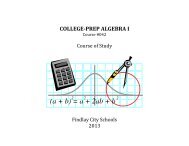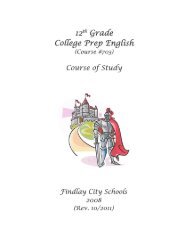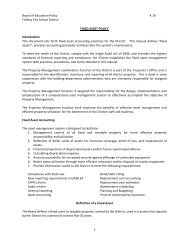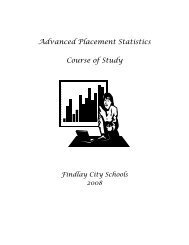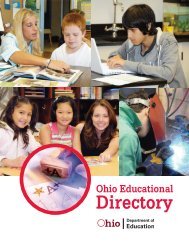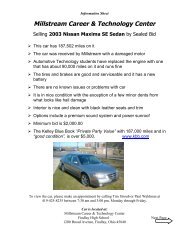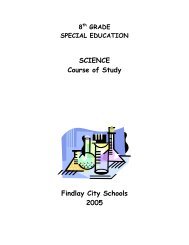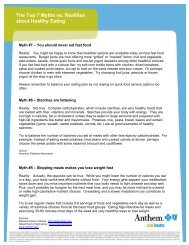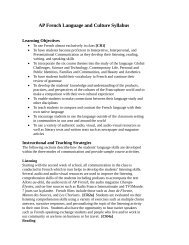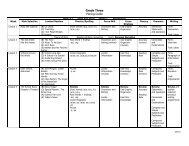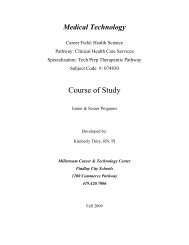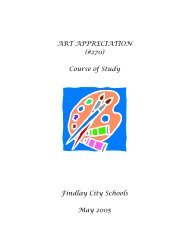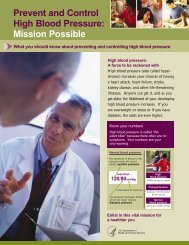Course of Study - Findlay City Schools
Course of Study - Findlay City Schools
Course of Study - Findlay City Schools
Create successful ePaper yourself
Turn your PDF publications into a flip-book with our unique Google optimized e-Paper software.
Hospitality and Restaurant Service<br />
Career Field: Hospitality and Tourism<br />
Pathway: Food Service and Lodging<br />
Specialization:<br />
Subject Code #: 330005<br />
<strong>Course</strong> <strong>of</strong> <strong>Study</strong><br />
Junior/Senior<br />
Developed by:<br />
Julie Lane<br />
Millstream Career & Technology Center<br />
<strong>Findlay</strong> <strong>City</strong> <strong>Schools</strong><br />
620 Lynn Street<br />
419-422-6297<br />
Fall 2009
Millstream’s Mission<br />
Educating Students ~<br />
Empowering Communities<br />
Millstream’s Goals<br />
1. All Millstream students will achieve career and education goals.<br />
2. All communities in the Career-Technical Planning District will<br />
perceive Millstream Career and Technology Center as a positive<br />
leader in career-technical education.<br />
3. All communities in the Career-Technical Planning District will<br />
strengthen communication and collaboration with all stakeholders.<br />
4. All Millstream students and staff will continually increase their<br />
career-specific skill levels.<br />
5. All members in the Career-Technical Planning District will ensure a<br />
culture <strong>of</strong> continuous improvement and innovation to attract a broader<br />
number <strong>of</strong> students.
<strong>Findlay</strong> <strong>City</strong> <strong>Schools</strong><br />
Mission Statement<br />
The mission <strong>of</strong> the <strong>Findlay</strong> <strong>City</strong> <strong>Schools</strong>, a community partnership committed to<br />
educational excellence, is to instill in each student the knowledge, skills and<br />
virtues necessary to be lifelong learners who recognize their unique talents and<br />
purpose and use them in pursuit <strong>of</strong> their dreams and for service to a global<br />
society.<br />
This is accomplished through a passion for knowledge, discovery and vision<br />
shared by students, families, staff and community.<br />
Beliefs<br />
Our beliefs form the ethical foundation <strong>of</strong> the <strong>Findlay</strong> <strong>City</strong> <strong>Schools</strong>.<br />
We believe…<br />
• every person has worth.<br />
• every individual can learn.<br />
• family is the most important influence on the development <strong>of</strong> personal<br />
values.<br />
• attitude is a choice and always affects performance.<br />
• motivation and effort are necessary to achieve full potential.<br />
• honesty and integrity are essential for building trust.<br />
• people are responsible for the choices they make.<br />
• performance is directly related to expectations.<br />
• educated citizens are essential for the survival <strong>of</strong> the democratic process.<br />
• personal fulfillment requires the nurturing <strong>of</strong> the mind, body and spirit.<br />
• every individual has a moral and ethical obligation to contribute to the wellbeing<br />
<strong>of</strong> society.<br />
• education is a responsibility shared by students, family, staff and<br />
community.<br />
• the entire community benefits by investing its time, resources and effort in<br />
educational excellence.<br />
• a consistent practice <strong>of</strong> shared morals and ethics is essential for our<br />
community to thrive.
Approval by Advisory Committee<br />
After reviewing this document, we recommend that the (name <strong>of</strong> your<br />
program) <strong>Course</strong> <strong>of</strong> <strong>Study</strong> be approved and adopted.<br />
__________________________<br />
Name<br />
__________________________<br />
Business<br />
__________________________<br />
Date<br />
___________________________<br />
Name<br />
___________________________<br />
Business<br />
___________________________<br />
Date<br />
__________________________<br />
Name<br />
__________________________<br />
Business<br />
__________________________<br />
Date<br />
___________________________<br />
Name<br />
___________________________<br />
Business<br />
___________________________<br />
Date<br />
__________________________<br />
Name<br />
__________________________<br />
Millstream Director<br />
__________________________<br />
Date<br />
___________________________<br />
Name<br />
___________________________<br />
Millstream Assistant Director<br />
___________________________<br />
Date
Curriculum Map<br />
Hospitality and Restaurant Services<br />
Week Unit Career-Technical Content Inquiry-Based Unit<br />
1 15/5.2 Safety and Sanitation/Environmental Services - laundry<br />
2 15/5.2 Safety and Sanitation/Environmental Services - laundry<br />
3 15/5.2 Safety and Sanitation/Environmental Services - laundry<br />
4 5 Safety, Health, and Environment Inquiry Based Lesson<br />
5 5 Safety, Health, and Environment Inquiry Based Lesson<br />
6 37 Safety, Health, and Security<br />
7 37 Safety, Health, and Security<br />
8 21 Equipment<br />
9 21 Equipment<br />
10 21 Equipment<br />
11 22 Food Preparation Basics<br />
12 22 Food Preparation Basics<br />
13 22 Food Preparation Basics<br />
14 22 Food Preparation Basics<br />
15 22 Food Preparation Basics<br />
16 22 Food Preparation Basics<br />
17 22 Food Preparation Basics<br />
18 22 Food Preparation Basics<br />
Semester Exams<br />
19 1 Career Exploration & Development<br />
20 1 Career Exploration & Development<br />
21 1 Career Exploration & Development<br />
22 5.3 Environmental Service –Facility Care<br />
23 5.3 Environmental Service –Facility Care<br />
24 5.3 Environmental Service –Facility Care<br />
25 5.3 Environmental Service –Facility Care<br />
26 5.3 Environmental Service –Facility Care<br />
27 5.3 Environmental Service –Facility Care<br />
28 5.3 Environmental Service –Facility Care<br />
29 13 Consumer Behavior & Customer Service Inquiry Based Lesson<br />
30 13 Consumer Behavior & Customer Service Inquiry Based Lesson<br />
31 13 Consumer Behavior & Customer Service Inquiry Based Lesson<br />
32 18 Customer Relations and Quality Service Inquiry Based Lesson<br />
33 18 Customer Relations and Quality Service Inquiry Based Lesson<br />
34 3 Communications<br />
35 3 Communications<br />
36 3 Communications<br />
End <strong>of</strong> Year Exams
Program Of <strong>Study</strong>
Millstream Career & Technology Center<br />
Hospitality and Restaurant Services 1 & II<br />
Instructor: Julie Lane Grade: 11 & 12<br />
Length: Full year-3 periods a day-2 credits lab and 1 credit related Cost: $35.00<br />
Units <strong>of</strong> Credit: 3 credits per year<br />
$10.00 FCCLA Due<br />
Prerequisite:<br />
$16.00 classroom Fees<br />
Program Location: Millstream South<br />
$ 9.00 Technology Fee<br />
<strong>Course</strong> Description:<br />
HOSPITALITY & FOOD SERVICES I & II<br />
Level I: Lab - 238 Related – 217<br />
Level II: Lab - 239 Related – 218<br />
Full year – 3 periods per day – 2 credits lab<br />
1 credit related<br />
This program is designed to prepare students for entry-level employment in the growing<br />
hospitality industry. Training emphasis is on providing environmental services <strong>of</strong> room<br />
keeping, laundry, banquet set-up, and food service in hotels, motels, hospitals, nursing<br />
homes, and restaurants. Safe work habits and employability skills are learned. An inhouse<br />
lab, as well as possible community sites, provides students with hands-on<br />
experiences. Students are members <strong>of</strong> FCCLA and participate in related activities.<br />
<strong>Course</strong> Goals: Students will learn how to operate and maintain an in house laundry business.<br />
Cleaning duties <strong>of</strong> lab and related rooms will be learned and regularly practiced. They will learn<br />
basic cooking techniques, various restaurant job descriptions and terminology related to the food<br />
service industry. Employability skills for acquiring and securing a job position will be learned<br />
and practiced through daily classroom and lab work.<br />
Student Expectations/Responsibilities/Requirements: Students will be expected to be on time<br />
and prepared for class. Attendance on a regular basis is mandatory. This program is designed<br />
with participation as its core. Students will be provided with a pencil, blank paper, and notebook<br />
which are to be kept in the classroom. Lab situations will require for shoulder length and longer<br />
hair to be pulled back, and closed toe, rubber sole shoes to be worn. Aprons, gloves and goggles<br />
will be provided and must be worn during appropriate lab situations. Classroom fees <strong>of</strong> $16.00<br />
will be used for goggles, gloves, notebooks, paper and cooking supplies. These dues are due at<br />
the beginning <strong>of</strong> the school year. $13.00 <strong>of</strong> the classroom fee will be attributed to FCCLA<br />
dues. $9.00 for technology fee.
Student Behavior Management Plan:<br />
Students will be required to follow all rules assigned by <strong>Findlay</strong> High School. Each student will<br />
receive a handbook which states all policies and regulations. The students will also be expected<br />
to follow classroom rules set up at the beginning <strong>of</strong> the year by each new class. Failure to oblige<br />
with these policies will result in detention after school and a parent contact. Father discipline<br />
infractions will result in administrative referral.<br />
Grading Procedures:<br />
A 100-92 %<br />
B 91-82 %<br />
C 81-72 %<br />
D 71-62 %<br />
F Below 62 %<br />
Student Youth Organizations:<br />
Each student will become a member <strong>of</strong> Family, Career and Community Leaders <strong>of</strong><br />
America. (FCCLA) The class will elect its own <strong>of</strong>ficers and hold meetings during class<br />
time. Individuals will be encouraged to participate in the “Power <strong>of</strong> One” competition,<br />
which is held at the end <strong>of</strong> the year. This is a project that encourages learning and<br />
individual growth through special projects. Awards and merits can be won to enhance<br />
senior passports.<br />
C:\MyFiles\Word Syllabus Form.wpd<br />
------------------------------------------------------------------------------------------------------------<br />
------------------------------------------------------<br />
Please acknowledge that you have fully read the requirements <strong>of</strong> the Hospitality and<br />
Food Service Program syllabus and understand the expectations related to this course.<br />
I have read and understand the requirements <strong>of</strong> the Hospitality and Food Service course<br />
syllabus.<br />
Name________________________________________________<br />
Date_______________________
Ohio<br />
Department<br />
<strong>of</strong><br />
Education<br />
Career<br />
Content<br />
Standards<br />
Career-Technical<br />
And Adult Education
Instructions for Review <strong>of</strong> the Technical Competencies<br />
Essential Competencies<br />
Those competencies marked Essential in the state pr<strong>of</strong>ile were determined by the statewide<br />
business panel to be necessary to ensure minimal levels <strong>of</strong> employability. Entry level employees<br />
should be able to perform this competency without supervision; therefore, students must be<br />
pr<strong>of</strong>icient in these competencies at least by the end <strong>of</strong> the Associate Degree.<br />
Essential competencies must be included in all Tech Prep programs. Wording <strong>of</strong> essential<br />
competencies may not be altered. The leveling may only be changed to deliver the competency<br />
earlier during the educational process. For example, the leveling <strong>of</strong> an essential competency in the<br />
state pr<strong>of</strong>ile may be altered local from a P or Pr<strong>of</strong>iciency leveling at the end <strong>of</strong> the Associate<br />
Degree to a P or Pr<strong>of</strong>iciency by the end <strong>of</strong> the 12 th grade. The reverse is not permissible. For<br />
example, competency leveled P or pr<strong>of</strong>icient by the end <strong>of</strong> the 12 th grade in the state pr<strong>of</strong>ile<br />
cannot be changed locally to a P or pr<strong>of</strong>iciency by the end <strong>of</strong> the Associate Degree.<br />
Competency descriptors are intended to help define each competency: therefore, the descriptors<br />
may be modified as long as the modifications does not change or dilute the intent <strong>of</strong> the state<br />
panel.<br />
Recommended Competencies<br />
The competencies marked Recommended are suggested additions to the state pr<strong>of</strong>ile. Each <strong>of</strong><br />
these competencies will be reviewed during the local competency pr<strong>of</strong>ile meetings; the joint<br />
panel <strong>of</strong> business and education representatives will decide whether to include each competency<br />
in the local curriculum. The decision should include consideration <strong>of</strong> local business needs, as well<br />
as priorities and time constraints <strong>of</strong> the educational process. Wording and leveling <strong>of</strong> all<br />
recommended competencies and builders may be modified.<br />
Additional Units/Competencies/Descriptors<br />
Competencies and/or descriptors may be added to any unit in the state pr<strong>of</strong>ile Additional units<br />
may also be added.<br />
Occupational Definitions<br />
Skills may be added to the occupation definitions based on the modifications made during the<br />
competency review. Because the definition is based on the skills detailed in the competency<br />
pr<strong>of</strong>ile, only minor modifications should be necessary.
Unit 15:<br />
BIL:<br />
Safety and Sanitation<br />
Essential<br />
EDU: 12 AD<br />
P<br />
R<br />
Competency 15.1: Examine safety procedures.<br />
Descriptors:<br />
15.1.1 Analyze the causes <strong>of</strong> accidents in culinary and foodservice operations.<br />
15.1.2 Identify electrical, mechanical and chemical hazards.<br />
15.1.3 Classify different types <strong>of</strong> fires and the appropriate extinguisher for each.<br />
15.1.4 Identify proper fire evacuation procedures.<br />
15.1.5 Maintain the traffic flow in compliance with established procedures.<br />
15.1.6 Explain the safe use <strong>of</strong> ladders.<br />
15.1.7 Detail proper lifting and carrying procedures.<br />
15.1.8 Follow established procedures for reporting accidents.<br />
Correlated Science Academic Content Benchmarks<br />
• Participate in and apply the processes <strong>of</strong> scientific investigation to create models and to<br />
design, conduct, evaluate and communicate the results <strong>of</strong> these investigations. (Scientific<br />
Inquiry A, 9-10)<br />
• Make appropriate choices when designing and participating in scientific investigations<br />
by using cognitive and manipulative skills when collecting data and formulating<br />
conclusions from the data. (Scientific Inquiry A, 11-12)<br />
BIL:<br />
Essential<br />
EDU: 12 AD<br />
P<br />
R<br />
Competency 15.2: Maintain compliance with health codes.<br />
Descriptors:<br />
15.2.1 Explain how sanitation and health codes apply to specific culinary and<br />
foodservice operations.<br />
15.2.2 Summarize sanitation regulations and inspection requirements for receiving,<br />
preparing, storing and serving food.<br />
15.2.3 Describe procedures for controlling the spread <strong>of</strong> disease.<br />
15.2.4 Demonstrate exemplary appearance and hygiene.<br />
15.2.5 Illustrate the correct uses <strong>of</strong> various utensils and kitchen equipment.<br />
15.2.6 Describe proper clothing and sanitation accessories.<br />
15.2.7 Practice the hazard analysis critical control point (HACCP) system.<br />
Correlated English Language Arts Academic Content Benchmarks<br />
• Use appropriate self-monitoring strategies for comprehension. (Reading Process C, 8-10;<br />
Reading Process C, 11-12)
Correlated Mathematics Academic Content Benchmarks<br />
• Construct convincing arguments based on analysis <strong>of</strong> data and interpretation <strong>of</strong> graphs.<br />
(Data Analysis and Probability F, 8-10)<br />
BIL:<br />
Essential<br />
EDU: 12 AD<br />
P<br />
R<br />
Competency 15.3: Practice sanitation duties.<br />
Descriptors:<br />
15.3.1 Clean and sanitize food contact surfaces.<br />
15.3.2 Clean nonfood contact surfaces and equipment.<br />
15.3.3 Wash, rinse, sanitize and store utensils and equipment.<br />
15.3.4 Establish cleaning schedules for food and nonfood contact surfaces.<br />
Correlated English Language Arts Academic Content Benchmarks<br />
• Produce functional documents that report, organize and convey information and ideas<br />
accurately, foresee readers’ problems or misunderstandings and that include formatting<br />
techniques that are user friendly. (Writing Applications C, 11-12)<br />
BIL:<br />
Essential<br />
EDU: 12 AD<br />
P<br />
R<br />
Competency 15.4: Control pests.<br />
Descriptors:<br />
15.4.1 Describe precautions that will help control pests.<br />
15.4.2 Clean spills and store food items in accordance with established procedures.<br />
15.4.3 Follow chemical labels and procedures.<br />
15.4.4 Describe signs <strong>of</strong> insect and pest infestation.<br />
BIL:<br />
Essential<br />
EDU: 12 AD<br />
P<br />
R<br />
Competency 15.5: Follow the hazard analysis critical control point (HACCP) system.<br />
Descriptors:<br />
15.5.1 Identify reasons that many common foods are potentially dangerous.<br />
15.5.2 Explain how time and temperature affect microorganism growth.<br />
15.5.3 Distinguish among food poisoning, chemical poisoning and food infection.<br />
15.5.4 Identify hazards related to food additives (e.g., monosodium glutamate (MSG).<br />
15.5.5 Explain biological hazards (e.g., bacteria, viruses, parasites).<br />
15.5.6 Summarize physical hazards (e.g., glass fragments, staples).<br />
15.5.7 Describe chemical hazards (e.g., cleaning agents, pesticides).
15.5.8 Identify and comply with standards established for the safe heating, reheating and<br />
cooling <strong>of</strong> foods.<br />
15.5.9 Describe good personal hygiene and how it affects food safety.<br />
15.5.10 List the steps in proper hand washing.<br />
15.5.11 Categorize and describe the microorganisms that cause food borne illnesses.<br />
15.5.12 Identify and list ways that chemical and physical hazards can contaminate food.<br />
15.5.13 Distinguish between situations in which contamination and cross-contamination<br />
can occur.<br />
15.5.14 List the conditions under which bacteria multiply rapidly, and use the letters<br />
FATTOM (food, acidity, time, temperate, oxygen, moisture).<br />
15.5.15 Define the food temperature danger zone and list temperatures that fall within<br />
that zone.<br />
15.5.16 Differentiate among types <strong>of</strong> thermometers and demonstrate how to use them.<br />
15.5.17 List the seven major steps in a HACCP food safety system.<br />
15.5.18 Outline proper procedures that include use <strong>of</strong> proper tools and equipment for<br />
receiving, storing, preparing, cooking, holding, cooling, reheating and serving<br />
food.<br />
15.5.19 Compare the different types <strong>of</strong> storage areas found in a culinary and foodservice<br />
operation.<br />
15.5.20 Define the difference between clean and sanitary.<br />
15.5.21 Practice procedures for cleaning and sanitizing tools and equipment.<br />
15.5.22 Maintain proper records.<br />
Correlated English Language Arts Academic Content Benchmarks<br />
• Use multiple resources to enhance comprehension <strong>of</strong> vocabulary. (Acquisition <strong>of</strong><br />
Vocabulary F, 8-10; Acquisition <strong>of</strong> Vocabulary E, 11-12)<br />
• Demonstrate comprehension <strong>of</strong> print and electronic text by responding to questions (e.g.,<br />
literal, inferential, evaluative and synthesizing). (Reading Process B, 8-10; Reading<br />
Process B, 11-12)<br />
Correlated Science Academic Content Benchmarks<br />
• Explain how processes at the cellular level affect the functions and characteristics <strong>of</strong> an<br />
organism. (Life Sciences A, 11-12)<br />
BIL:<br />
Essential<br />
EDU: 12 AD<br />
P<br />
R<br />
Competency 15.6: Explain garbage disposal procedures.<br />
Descriptors:<br />
15.6.1 Summarize the standards established for safe handling, maintenance and disposal<br />
<strong>of</strong> garbage, grease and refuse.<br />
15.6.2 Describe garbage container sanitation and maintenance.<br />
15.6.3 Explain established procedures for operating garbage disposals.<br />
15.6.4 Comply with environmental guidelines related to the disposal <strong>of</strong> garbage and<br />
wastes.
Correlated English Language Arts Academic Content Benchmarks<br />
• Demonstrate comprehension <strong>of</strong> print and electronic text by responding to questions (e.g.,<br />
literal, inferential, evaluative and synthesizing). (Reading Process B, 8-10; Reading<br />
Process B, 11-12)<br />
BIL:<br />
Essential<br />
EDU: 12 AD<br />
P<br />
R<br />
Competency 15.7: Maintain a safe work environment.<br />
Descriptors:<br />
15.7.1 State the hazard communication standard required for employers.<br />
15.7.2 Describe the ways <strong>of</strong> preventing burns.<br />
15.7.3 Outline proper procedures for cleaning floors.<br />
15.7.4 Locate and list hazards that can cause cuts.<br />
15.7.5 Demonstrate correct and safe use <strong>of</strong> knives.<br />
15.7.6 List safe driving techniques.<br />
15.7.7 Explain the importance <strong>of</strong> the general safety audit.<br />
15.7.8 List ways <strong>of</strong> using protective clothing and equipment to prevent injuries.<br />
Correlated English Language Arts Academic Content Benchmarks<br />
• Demonstrate comprehension <strong>of</strong> print and electronic text by responding to questions (e.g.,<br />
literal, inferential, evaluative and synthesizing). (Reading Process B, 8-10; Reading<br />
Process B, 11-12)<br />
Unit 5:<br />
Safety, Health and Environment<br />
Note: Throughout the “Safety, Health and Environmental” unit, students are expected to learn<br />
and use vocabulary specific to the topic. Correlations to the English Language Arts Acquisition <strong>of</strong><br />
Vocabulary standard include the following benchmarks:<br />
• Apply knowledge <strong>of</strong> roots, affixes and phrases to aid understanding <strong>of</strong> content area<br />
vocabulary. (Acquisition <strong>of</strong> Vocabulary D, 11-12)<br />
• Use multiple resources to enhance comprehension <strong>of</strong> vocabulary. (Acquisition <strong>of</strong><br />
Vocabulary F, 8-10; Acquisition <strong>of</strong> Vocabulary E, 11-12)<br />
BIL:<br />
Essential<br />
EDU: 12 AD<br />
P<br />
R<br />
Competency 5.1: Follow safety procedures.<br />
Descriptors:<br />
5.1.1 Identify electrical and mechanical hazards.<br />
5.1.2 Classify different types <strong>of</strong> fires and how to contain them.<br />
5.1.3 Identify and follow proper fire evacuation procedures.<br />
5.1.4 Outline proper response to emergency situations.
5.1.5 Apply basic first aid and CPR procedures in compliance with established<br />
procedures.<br />
5.1.6 Follow safety and security procedures.<br />
Correlated English Language Arts Academic Content Benchmarks<br />
• Demonstrate comprehension <strong>of</strong> print and electronic text by responding to questions (e.g.,<br />
literal, inferential, evaluative and synthesizing). (Reading Process B, 8-10; Reading<br />
Process B, 11-12)<br />
Correlated Science Academic Content Benchmarks<br />
• Participate in and apply the processes <strong>of</strong> scientific investigation to create models and to<br />
design, conduct, evaluate and communicate the results <strong>of</strong> these investigations. (Scientific<br />
Inquiry, A, 9-10)<br />
• Make appropriate choices when designing and participating in scientific investigations<br />
by using cognitive and manipulative skills when collecting data and formulating<br />
conclusions from the data. (Scientific Inquiry, A, 11-12)<br />
BIL:<br />
Essential<br />
EDU: 12 AD<br />
P<br />
R<br />
Competency 5.2: Apply sanitation procedures.<br />
Descriptors:<br />
5.2.1 Outline the compliance requirements <strong>of</strong> sanitation, safety and health inspections.<br />
5.2.2 Use appropriate safety equipment and clothing.<br />
5.2.3 Identify and describe OSHA standards.<br />
5.2.4 Contrast sanitizing and cleaning procedures.<br />
5.2.5 Follow sanitizing procedures.<br />
Correlated English Language Arts Academic Content Benchmarks<br />
• Demonstrate comprehension <strong>of</strong> print and electronic text by responding to questions (e.g.,<br />
literal, inferential, evaluative and synthesizing). (Reading Process B, 8-10; Reading<br />
Process B, 11-12)<br />
BIL:<br />
Recommended<br />
EDU: 12 AD<br />
P<br />
R<br />
Competency 5.3: Examine the impacts <strong>of</strong> life choices on careers.<br />
Descriptors:<br />
5.3.1 List the effects <strong>of</strong> exercise on job performance.<br />
5.3.2 Discuss the effects <strong>of</strong> nutrition and dietary habits on job performance.<br />
5.3.3 Interpret the effects <strong>of</strong> stress, fatigue and anxiety on job performance.<br />
BIL:<br />
Essential
EDU: 12 AD<br />
P<br />
R<br />
Competency 5.4: Apply government and health regulations standards for hazardous<br />
materials handling and storage.<br />
Descriptors:<br />
5.4.1 Identify types <strong>of</strong> hazardous materials.<br />
5.4.2 Interpret container label precautions.<br />
5.4.3 Interpret material safety data sheets (MSDS) and use materials accordingly.<br />
5.4.4 Explain storage procedures for hazardous materials that are in accordance with<br />
government regulations.<br />
5.4.5 Describe disposal procedures for hazardous materials that are in accordance with<br />
government regulations.<br />
5.4.6 Examine a hazardous materials safety plan.<br />
Correlated English Language Arts Academic Content Benchmarks<br />
• Demonstrate comprehension <strong>of</strong> print and electronic text by responding to questions (e.g.,<br />
literal, inferential, evaluative and synthesizing). (Reading Process B, 8-10; Reading<br />
Process B, 11-12)<br />
• Use appropriate self-monitoring strategies for comprehension. (Reading Process C, 8-10;<br />
Reading Process C, 11-12)<br />
Correlated Science Academic Content Benchmarks<br />
• Participate in and apply the processes <strong>of</strong> scientific investigation to create models and to<br />
design, conduct, evaluate and communicate the results <strong>of</strong> these investigations. (Scientific<br />
Inquiry, A, 9-10)<br />
• Make appropriate choices when designing and participating in scientific investigations<br />
by using cognitive and manipulative skills when collecting data and formulating<br />
conclusions from the data. (Scientific Inquiry, A, 11-12)<br />
BIL:<br />
Recommended<br />
EDU: 12 AD<br />
I<br />
P<br />
Competency 5.5: Develop safety and security strategies to minimize risks for<br />
individuals and groups in multiple environments.<br />
Descriptors:<br />
5.5.1 Create a solution for guests’ and customers’ exposure to a health hazard.<br />
5.5.2 Suggest ways to manage guests and customers facing a threat.<br />
5.5.3 Create ways to prevent common safety hazards.<br />
5.5.4 Develop and role play mock emergency situations.<br />
5.5.5 Outline how locking systems protect guests and/or customers.<br />
5.5.6 Create a security system using surveillance cameras.<br />
5.5.7 Design a security system using security personnel.<br />
5.5.8 Detail ways to use lighting to increase security.<br />
5.5.9 Identify liability responsibilities.
Correlated English Language Arts Academic Content Benchmarks<br />
• Demonstrate an understanding <strong>of</strong> effective speaking strategies by selecting appropriate<br />
language and adjusting presentation techniques. (Communication: Oral and Visual D, 8-<br />
10)<br />
• Select and use effective speaking strategies for a variety <strong>of</strong> audiences, situations and<br />
purposes. (Communication: Oral and Visual C, 11-12)<br />
BIL:<br />
Essential<br />
EDU: 12 AD<br />
I<br />
P<br />
Competency 5.6: Process safety documentation.<br />
Descriptors:<br />
5.6.1 Identify the forms required to document accidents and emergency events.<br />
5.6.2 Complete and file accident reports in accordance with required standards.<br />
5.6.3 Describe the impacts <strong>of</strong> accidents on workers’ compensation and insurance<br />
bonding.<br />
Correlated English Language Arts Academic Content Benchmarks<br />
• Evaluate how features and characteristics make information accessible and usable and<br />
how structures help authors achieve their purposes. (Reading Applications:<br />
Informational, Technical and Persuasive Text A, 8-10)<br />
• Produce functional documents that report, organize and convey information and ideas<br />
accurately, foresee readers’ problems or misunderstandings and that include formatting<br />
techniques that are user friendly. (Writing Applications C, 11-12)<br />
BIL: Essential<br />
EDU: 12 AD<br />
P<br />
R<br />
Competency 5.7: Comply with emergency procedures.<br />
Descriptors:<br />
5.7.1 Maintain emergency exits.<br />
5.7.2 Identify the location <strong>of</strong> power sources controls and communication equipment.<br />
5.7.3 Demonstrate procedures for extinguishing class A, B and D fires.<br />
5.7.4 Identify the location <strong>of</strong> fire suppression equipment.<br />
5.7.5 Identify the procedures for weather emergencies.<br />
5.7.6 Identify procedures to be followed in the event <strong>of</strong> a robbery.<br />
5.7.7 Comply with the emergency medical plan in medical emergencies.<br />
5.7.8 Specify procedures necessary based on the national threat level.<br />
5.7.9 Examine and disseminate information to help customers deal with potential<br />
safety hazards and security issues.<br />
Correlated English Language Arts Academic Content Benchmarks
• Apply reading comprehension strategies to understand grade-appropriate text. (Reading<br />
Process A, 8-10; Reading Process A, 11-12)<br />
• Evaluate how features and characteristics make information accessible and usable and<br />
how structures help authors achieve their purposes. (Reading Applications:<br />
Informational, Technical and Persuasive Text A, 8-10)<br />
BIL:<br />
Essential<br />
EDU: 12 AD<br />
P<br />
R<br />
Competency 5.8: Explain safety and security polices and procedures.<br />
Descriptors:<br />
5.8.1 Formulate methods <strong>of</strong> resolution and/or alternatives for eliminating potential<br />
safety hazards.<br />
5.8.2 Describe sources to utilize in various emergency situations for self, co-workers,<br />
and customers and/or guests.<br />
Correlated English Language Arts Academic Content Benchmarks<br />
• Apply reading comprehension strategies to understand grade-appropriate text. (Reading<br />
Process A, 8-10; Reading Process A, 11-12)<br />
• Evaluate how features and characteristics make information accessible and usable and<br />
how structures help authors achieve their purposes. (Reading Applications:<br />
Informational, Technical and Persuasive Text A, 8-10)<br />
BIL:<br />
Essential<br />
EDU: 12 AD<br />
P<br />
R<br />
Competency 5.9: Assess strategies for handling medical emergencies.<br />
Descriptors:<br />
5.9.1 Predict the range <strong>of</strong> medical emergencies that could occur.<br />
5.9.2 Describe the equipment and materials that should be kept on hand.<br />
5.9.3 Explain the policies and procedures for addressing a variety <strong>of</strong> medical<br />
emergencies.<br />
5.9.4 Identify the necessary contact information needed for medical emergencies.<br />
5.9.5 Review the parameters and legal constraints <strong>of</strong> dealing with medical<br />
emergencies.<br />
BIL:<br />
Essential<br />
EDU: 12 AD<br />
P<br />
R<br />
Competency 5.10: Assess strategies for handling demonstrations and confrontations<br />
Descriptors:<br />
5.10.1 Differentiate between demonstrations and confrontations.<br />
5.10.2 Describe the emergency action plan for demonstrations and confrontations.
5.10.3 Explain the relationships with law enforcement <strong>of</strong>ficials when dealing with<br />
situations.<br />
5.10.4 Explain policies and procedures for accommodating the rights <strong>of</strong> demonstrators<br />
(e.g., union strikes).<br />
5.10.5 Describe strategies for preventing escalation <strong>of</strong> volatile situations<br />
5.10.6 Outline safety and security issues for individuals and groups in multiple<br />
environments to minimize risks<br />
5.10.7 Explain potential, real and perceived natural, social and terrorism-related<br />
emergency situations<br />
Correlated English Language Arts Academic Content Benchmarks<br />
• Apply reading comprehension strategies to understand grade-appropriate text. (Reading<br />
Process A, 8-10; Reading Process A, 11-12)<br />
• Evaluate how features and characteristics make information accessible and usable and<br />
how structures help authors achieve their purposes. (Reading Applications:<br />
Informational, Technical and Persuasive Text A, 8-10)<br />
BIL:<br />
Essential<br />
EDU: 12 AD<br />
P<br />
R<br />
Competency 5.11: Assess strategies for handling emergency evacuations.<br />
Descriptors:<br />
5.11.1 Identify situations that would require evacuation.<br />
5.11.2 Explain the fire and environmental safety policies and evacuation procedures.<br />
5.11.3 Explain the bomb threat policies and evacuation procedures.<br />
5.11.4 Explain the emergency weather related policies and procedures.<br />
5.11.5 Explain the procedures for dealing with unauthorized persons who pose a threat.<br />
Unit 37:<br />
BIL:<br />
Safety, Health and Security<br />
Essential<br />
EDU: 12 AD<br />
P<br />
R<br />
Competency 37.1: Explain general safety and security polices and procedures.<br />
Descriptors:<br />
37.1.1 Outline safety and security issues for individuals and groups in multiple<br />
environments, to minimize risks.<br />
37.1.2 Explain potential, real and perceived natural, social or terrorism emergency<br />
situations.<br />
37.1.3 Formulate methods <strong>of</strong> resolution and/or alternatives for eliminating potential<br />
safety hazards.<br />
37.1.4 Describe sources to utilize in various emergency situations for self, co-workers<br />
and customers and guests.<br />
37.1.5 Examine and disseminate information to help customers deal with potential<br />
safety hazards and security issues.
Correlated English Language Arts Academic Content Benchmarks<br />
• Apply reading comprehension strategies to understand grade-appropriate text. (Reading<br />
Process A, 8-10; Reading Process A, 11-12)<br />
• Evaluate how features and characteristics make information accessible and usable and<br />
how structures help authors achieve their purposes. (Reading Applications:<br />
Informational, Technical and Persuasive Text A, 8-10)<br />
BIL:<br />
Essential<br />
EDU: 12 AD<br />
P<br />
R<br />
Competency 37.2: Identify strategies for handling medical emergencies.<br />
Descriptors:<br />
37.2.1 Consider the range <strong>of</strong> medical emergencies that could occur.<br />
37.2.2 Describe the appropriate equipment and materials that should be kept on hand.<br />
37.2.3 Explain the policies and procedures for addressing a variety <strong>of</strong> medical<br />
emergencies.<br />
37.2.4 Identify the necessary contact information needed for medical emergencies.<br />
37.2.5 Review the parameters and legal constraints <strong>of</strong> dealing with medical<br />
emergencies.<br />
Correlated English Language Arts Academic Content Benchmarks<br />
• Demonstrate comprehension <strong>of</strong> print and electronic text by responding to questions (e.g.,<br />
literal, inferential, evaluative and synthesizing). (Reading Process B, 8-10; Reading<br />
Process B, 11-12)<br />
BIL:<br />
Essential<br />
EDU: 12 AD<br />
I<br />
P<br />
Competency 37.3: Identify strategies for handling demonstrations and confrontations.<br />
Descriptors:<br />
37.3.1 Differentiate between a demonstration and a confrontation.<br />
37.3.2 Describe the emergency action plan for demonstrations and confrontations.<br />
37.3.3 Explain the relationships with law enforcement <strong>of</strong>ficials for dealing with<br />
situations.<br />
37.3.4 Explain policies and procedures for accommodating the rights <strong>of</strong> demonstrators<br />
(e.g., union strikes).<br />
37.3.5 Describe strategies for preventing escalation <strong>of</strong> volatile situations.<br />
BIL:<br />
Essential<br />
EDU: 12 AD<br />
P<br />
R
Competency 37.4: Identify strategies for handling emergency evacuations.<br />
Descriptors:<br />
37.4.1 Identify situations that would require evacuation.<br />
37.4.2 Explain the fire and environmental safety policies and evacuation procedures.<br />
37.4.3 Explain the bomb threat polices and evacuation procedures.<br />
37.4.4 Explain the emergency weather related policies and procedures.<br />
37.4.5 Explain the procedures for dealing with unauthorized persons who pose a threat.<br />
Correlated English Language Arts Academic Content Benchmarks<br />
• Demonstrate comprehension <strong>of</strong> print and electronic text by responding to questions (e.g.,<br />
literal, inferential, evaluative and synthesizing). (Reading Process B, 8-10; Reading<br />
Process B, 11-12)<br />
BIL:<br />
Essential<br />
EDU: 12 AD<br />
I<br />
P<br />
Competency 37.5: Develop and implement an individualized security program.<br />
Descriptors:<br />
37.5.1 Discuss the legal concerns involved with providing safe and secure<br />
accommodations for guests.<br />
37.5.2 Identify considerations in setting up a security program.<br />
37.5.3 Compare and contrast the various methods <strong>of</strong> security staffing.<br />
37.5.4 Describe the functions <strong>of</strong> a wide variety <strong>of</strong> security equipment (e.g. physical<br />
security systems, surveillance systems, alarm systems, guestroom security<br />
systems, communication systems).<br />
37.5.5 Describe the purposes for security procedures that deal with guest protection.<br />
37.5.6 Explain the values <strong>of</strong> and procedures for accurate report writing and<br />
recordkeeping.<br />
37.5.7 Identify the types <strong>of</strong> emergencies that need to be addressed in a crisis<br />
management plan.<br />
37.5.8 Create policies for guests and employees related to emergency procedures.<br />
37.5.9 Train and drill staff on all policies and procedures.<br />
37.5.10 Identify a media spokesperson for all crisis situations.<br />
Correlated English Language Arts Academic Content Benchmarks<br />
• Produce functional documents that report, organize and convey information and ideas<br />
accurately, foresee readers’ problems or misunderstandings and that include formatting<br />
techniques that are user friendly. (Writing Applications C, 11-12)
Unit 21:<br />
BIL:<br />
Equipment<br />
Essential<br />
EDU: 12 AD<br />
I<br />
P<br />
Competency 21.1: Demonstrate operation <strong>of</strong> food preparation equipment.<br />
Descriptors:<br />
21.1.1 Arrange equipment for efficient access and use.<br />
21.1.2 Operate ovens (e.g., standard, infrared, conventional).<br />
21.1.3 Utilize a variety <strong>of</strong> food preparation equipment (e.g., ranges, mixers, fryer units,<br />
toasters, grills).<br />
21.1.4 Maintain food preparation equipment according to manufacturers’ specifications,<br />
warranties and service agreements.<br />
21.1.5 Troubleshoot equipment problems and employ preventive measures.<br />
21.1.6 Use scales and carts to receive food and supplies.<br />
21.1.7 Demonstrate measuring and portioning foods using ladles, measuring cups,<br />
spoons, scales and scoops.<br />
21.1.8 Cut and mix foods using standard kitchen equipment.<br />
21.1.9 Maintain calibration <strong>of</strong> equipment, and log where required.<br />
Correlated English Language Arts Academic Content Benchmarks<br />
• Use appropriate self-monitoring strategies for comprehension. (Reading Process C, 8-10;<br />
Reading Process C, 11-12)<br />
BIL:<br />
Essential<br />
EDU: 12 AD<br />
P<br />
R<br />
Competency 21.2: Demonstrate operation <strong>of</strong> nonfood kitchen equipment.<br />
Descriptors:<br />
21.2.1 Describe the setup and function <strong>of</strong> compartment sinks.<br />
21.2.2 Operate dishwashing machines, trash compactors and other equipment.<br />
21.2.3 Maintain waste disposals, refrigerators, ventilation hoods and freezers according<br />
to manufacturers’ specifications.<br />
21.2.4 Follow established procedures for the safe handling and use <strong>of</strong> cleaning<br />
equipment.
Unit 22:<br />
BIL:<br />
Food Preparation Basics<br />
Essential<br />
EDU: 12 AD<br />
P<br />
R<br />
Competency 22.1: Apply calculations essential to culinary.<br />
Descriptors:<br />
22.1.1 Measure liquids and solids by weight or volume using appropriate equipment.<br />
22.1.2 Measure food temperature.<br />
22.1.3 Convert recipes to meet specific quantity needs.<br />
22.1.4 Calculate nutritional information per serving (e.g., calories, fat grams).<br />
22.1.5 Calculate menu and recipe costs.<br />
Correlated Mathematics Academic Content Benchmarks<br />
• Compare, order and determine equivalent forms <strong>of</strong> real numbers. (Number, Number<br />
Sense and Operations E, 8-10)<br />
• Estimate, compute and solve problems involving real numbers, including ratio,<br />
proportion and percent, and explain solutions. (Number, Number Sense and Operations<br />
G, 8-10)<br />
• Write and solve real-world, multi-step problems involving money, elapsed time and<br />
temperature, and verify reasonableness <strong>of</strong> solutions. (Measurement F, 8-10)<br />
BIL:<br />
Essential<br />
EDU: 12 AD<br />
P<br />
R<br />
Competency 22.2: Demonstrate artistic presentation.<br />
Descriptors:<br />
22.2.1 Explain how shapes, colors, textures and design relate to food preparation and<br />
presentation.<br />
22.2.2 Describe the importance <strong>of</strong> the senses as they relate to food preparation and<br />
presentation.<br />
22.2.3 Apply creativity during food preparation and presentation.<br />
22.2.4 Determine themes for special occasions.<br />
22.2.5 Enhance food presentations using various techniques.<br />
22.2.6 Show consistent appearance in prepared foods.<br />
22.2.7 Describe and prepare ingredients commonly used as garnishes.<br />
22.2.8 Demonstrate garnishing plates.<br />
BIL:<br />
Essential<br />
EDU: 12 AD<br />
I<br />
P
Competency 22.3: Demonstrate scientific knowledge <strong>of</strong> food preparation, storage and<br />
presentation.<br />
Descriptors:<br />
22.3.1 Describe thermal energy transfer in the preparation, storage and presentation <strong>of</strong><br />
food.<br />
22.3.2 Describe undesirable microbial growth in food.<br />
22.3.3 Explain acidity as it relates to food preparation, storage and presentation.<br />
22.3.4 Describe the action <strong>of</strong> water in food preparation, storage and presentation.<br />
22.3.5 Recognize various types <strong>of</strong> chemical reactions during food preparation, storage<br />
and presentation.<br />
22.3.6 Explain how lipids affect the texture and tenderness <strong>of</strong> bakery products.<br />
22.3.7 Differentiate among various solutions, colloids and emulsions.<br />
22.2.8 Explain how oxidation affects foods.<br />
22.3.9 Describe the effects <strong>of</strong> pressure, including altitude, on cooking.<br />
Correlated Science Academic Content Benchmarks<br />
• Explain how atoms react with each other to form other substances and how molecules<br />
react with each other or other atoms to form even different substances. (Physical<br />
Sciences B, 9-10)<br />
• Describe the identifiable physical properties <strong>of</strong> substances (e.g., color, hardness,<br />
conductivity, density, concentration and ductility). Explain how changes in these<br />
properties can occur without changing the chemical nature <strong>of</strong> the substance. (Physical<br />
Sciences C, 9-10)<br />
• Explain how energy may change form or be redistributed but the total quantity <strong>of</strong> energy<br />
is conserved. (Physical Sciences F, 9-10)<br />
BIL:<br />
Essential<br />
EDU: 12 AD<br />
P<br />
R<br />
Competency 22.4: Prepare mise en place.<br />
Descriptors:<br />
22.4.1 Select the utensils, containers and equipment appropriate for the task to be<br />
performed.<br />
22.4.2 Sanitize the utensils, containers, equipment and work space.<br />
22.4.3 Assemble needed recipes and ingredients.<br />
22.4.4 Apply work efficiency principles in setting up a work space.<br />
22.4.5 Maintain food safety.<br />
22.4.6 Restore the area to a sanitary condition.<br />
BIL:<br />
Essential<br />
EDU: 12 AD<br />
P<br />
R<br />
Competency 22.5:<br />
Descriptors:<br />
Demonstrate various cutting operations.
22.5.1 Identify tools for cutting by hand.<br />
22.5.2 Identify the types <strong>of</strong> knives for specific cuts.<br />
22.5.3 Employ standard safety precautions while performing classical cuts.<br />
22.5.4 Demonstrate standard safety precautions while performing cuts using mechanical<br />
cutting tools (e.g., mandolin, food processor, chopper).<br />
22.5.5 Sharpen, wash, rinse, sanitize and store cutting tools according to standards.<br />
22.5.6 Demonstrate established procedures for the safe handling and use <strong>of</strong> knives,<br />
shredders, choppers and other cutting tools.<br />
BIL:<br />
Essential<br />
EDU: 12 AD<br />
P<br />
R<br />
Competency 22.6: Apply basic kitchen cooking techniques.<br />
Descriptors:<br />
22.6.1 Identify the components and functions <strong>of</strong> a standardized recipe.<br />
22.6.2 Describe the uses for common liquid and dry measure tools.<br />
22.6.3 Explain the difference between customary and metric units <strong>of</strong> measurement.<br />
22.6.4 Apply effective misế en place through practice.<br />
22.6.5 List common spices and herbs and describe their uses.<br />
22.6.6 Describe and demonstrate several basic preparation techniques, including<br />
clarifying butter, separating eggs, whipping egg whites and making parchment<br />
liners.<br />
22.6.7 Describe dry-heat cooking methods and list the foods for which they are suited.<br />
22.6.8 Describe moist-heat cooking methods and list the foods for which they are suited.<br />
22.6.9 Describe combination cooking methods and list the foods for which they are<br />
suited.<br />
Correlated Mathematics Academic Content Benchmarks<br />
• Compare, order and determine equivalent forms <strong>of</strong> real numbers. (Number, Number<br />
Sense and Operations E, 8-10)<br />
• Apply mathematical knowledge and skills routinely in other content areas and practical<br />
situations. (Mathematical Processes B, 8-10)<br />
Unit 1:<br />
BIL:<br />
Career Exploration and Development<br />
Essential<br />
EDU: 12 AD<br />
P<br />
R<br />
Competency 1.1: Examine the numerous career pathways within hospitality and<br />
tourism.<br />
Descriptors:<br />
1.1.1 Identify current and future career options in hospitality and tourism.<br />
1.1.2 Identify education and training needed for entry-level, skilled level and<br />
supervisory level careers in hospitality and tourism.<br />
1.1.3 Identify personal characteristics required for individuals working in this field.
1.1.4 Examine the advantages and disadvantages <strong>of</strong> working in independently-owned<br />
facilities, non-pr<strong>of</strong>it associations or chain-affiliated facilities.<br />
1.1.5 Match individual interests, abilities and preferences to career preferences.<br />
1.1.6 Identify key terms and principles associated with the hospitality and tourism<br />
industry.<br />
Correlated English Language Arts Academic Content Benchmarks<br />
• Use context clues and text structures to determine the meaning <strong>of</strong> new vocabulary.<br />
(Acquisition <strong>of</strong> Vocabulary A, 8-10)<br />
• Demonstrate comprehension <strong>of</strong> print and electronic text by responding to questions (e.g.,<br />
literal, inferential, evaluative and synthesizing). (Reading Process B, 8-10; Reading<br />
Process B, 11-12)<br />
• Evaluate the usefulness and credibility <strong>of</strong> data and sources. (Research B, 8-10)<br />
• Compile, organize and evaluate information, take notes and summarize findings.<br />
(Research B, 11-12)<br />
• Evaluate the usefulness and credibility <strong>of</strong> data and sources and synthesize information<br />
from multiple sources. (Research C, 11-12)<br />
Correlated Mathematics Academic Content Benchmarks<br />
• Apply mathematical knowledge and skills routinely in other content areas and practical<br />
situations. (Mathematical Processes B, 8-10)<br />
• Locate and interpret mathematical information accurately, and communicate ideas,<br />
processes and solutions in a complete and easily understood manner. (Mathematical<br />
Processes H, 8-10)<br />
BIL:<br />
Essential<br />
EDU: 12 AD<br />
I<br />
P<br />
Competency 1.2: Explore pr<strong>of</strong>essional development opportunities.<br />
Descriptors:<br />
1.2.1 Research continuing education and pr<strong>of</strong>essional development courses to advance<br />
skills or remain current in the pr<strong>of</strong>ession.<br />
1.2.2 Identify licenses, certifications and credentials applicable to specific careers.<br />
1.2.3 Maintain a résumé, a list <strong>of</strong> references, resource files, and a portfolio <strong>of</strong> work<br />
experience, licenses and certifications.<br />
1.2.4 Identify pr<strong>of</strong>essional associations available in this industry.<br />
1.2.5 Identify pr<strong>of</strong>essional journals and publications.<br />
1.2.6 Interact with hospitality and tourism pr<strong>of</strong>essionals by building internal and<br />
external mentor relationships.<br />
Correlated English Language Arts Academic Content Benchmarks
• Produce functional documents that report, organize and convey information and ideas<br />
accurately, foresee readers’ problems or misunderstandings and that include formatting<br />
techniques that are user friendly. (Writing Applications C, 11-12)<br />
• Compile, organize and evaluate information, take notes and summarize findings.<br />
(Research B, 11-12)<br />
• Use a variety <strong>of</strong> strategies to enhance listening comprehension. (Communication: Oral<br />
and Visual A, 8-10; Communication: Oral and Visual A, 11-12)<br />
BIL:<br />
Essential<br />
EDU: 12 AD<br />
I<br />
P<br />
Competency 1.3: Examine the benefits and costs <strong>of</strong> the hospitality and tourism<br />
industry at the local, regional, state, national and international<br />
levels.<br />
Descriptors:<br />
1.3.1 Examine economic benefits and costs.<br />
1.3.2 Examine social benefits and costs.<br />
1.3.3 Examine cultural benefits and costs.<br />
1.3.4 Examine environmental benefits and costs.<br />
Correlated English Language Arts Academic Content Benchmarks<br />
• Compile, organize and evaluate information, take notes and summarize findings.<br />
(Research B, 11-12)<br />
Correlated Mathematics Academic Content Benchmarks<br />
• Create, interpret and use graphical displays and statistical measures to describe data;<br />
e.g., box-and-whisker plots, histograms, scatterplots, measures <strong>of</strong> center and variability.<br />
(Data Analysis and Probability A, 8-10)<br />
• Construct convincing arguments based on analysis <strong>of</strong> data and interpretation <strong>of</strong> graphs.<br />
(Data Analysis and Probability F, 8-10)<br />
• Locate and interpret mathematical information accurately, and communicate ideas,<br />
processes and solutions in a complete and easily understood manner. (Mathematical<br />
Processes H, 8-10)<br />
Correlated Science Academic Content Benchmarks<br />
• Explain that humans are an integral part <strong>of</strong> the Earth’s system and the choices humans<br />
make today impact natural systems in the future. (Earth and Space Sciences C, 11-12)<br />
• Describe how human activities can impact the status <strong>of</strong> natural systems. (Life Sciences<br />
G, 9-10)<br />
BIL:<br />
Recommended<br />
EDU: 12 AD<br />
I<br />
P
Competency 1.4: Explore the characteristics and trends related to domestic and<br />
international travelers.<br />
Descriptors:<br />
1.4.1 Explore demographics concerning domestic and international business and<br />
leisure travelers.<br />
1.4.2 Explore geographic origins <strong>of</strong> domestic and international business and leisure<br />
travelers.<br />
1.4.3 Explore the psychographic characteristics <strong>of</strong> and trends related to domestic and<br />
international business and leisure travelers.<br />
1.4.4 Explore travelers’ motivations, needs and expectations concerning international<br />
and domestic business and leisure travel.<br />
Correlated English Language Arts Academic Content Benchmarks<br />
• Formulate open-ended research questions suitable for investigation and adjust questions<br />
as necessary while research is conducted. (Research A, 8-10)<br />
• Formulate open-ended research questions suitable for inquiry and investigation and<br />
adjust questions as necessary while research is conducted. (Research A, 11-12)<br />
• Compile, organize and evaluate information, take notes and summarize findings.<br />
(Research B, 11-12)<br />
Correlated Mathematics Academic Content Benchmarks<br />
• Locate and interpret mathematical information accurately, and communicate ideas,<br />
processes and solutions in a complete and easily understood manner. (Mathematical<br />
Processes H, 8-10)<br />
BIL:<br />
Essential<br />
EDU: 12 AD<br />
I<br />
P<br />
Competency 1.5: Examine the development, growth and future <strong>of</strong> the hospitality and<br />
tourism industry.<br />
Descriptors:<br />
1.5.1 Identify the origins <strong>of</strong> the hospitality and tourism industry.<br />
1.5.2 Examine major growth stages in the industry and their causes.<br />
1.5.3 Identify the scope <strong>of</strong> the industry and overall trends in the hospitality and tourism<br />
industry at the local, state, national and international levels.<br />
1.5.4 Identify major actions <strong>of</strong> the hospitality and tourism industry that create growth.<br />
1.5.5 Describe the impact <strong>of</strong> local, state, national and international events on the<br />
hospitality and tourism industry (e.g., impact <strong>of</strong> 9/11, natural disasters, personal<br />
safety).<br />
Correlated English Language Arts Academic Content Benchmarks
• Compile, organize and evaluate information, take notes and summarize findings.<br />
(Research B, 11-12)<br />
Correlated Mathematics Academic Content Benchmarks<br />
• Apply mathematical knowledge and skills routinely in other content areas and practical<br />
situations. (Mathematical Processes B, 8-10)<br />
• Locate and interpret mathematical information accurately, and communicate ideas,<br />
processes and solutions in a complete and easily understood manner. (Mathematical<br />
Processes H, 8-10)<br />
BIL:<br />
Recommended<br />
EDU: 12 AD<br />
I<br />
R<br />
Competency 1.6: Participate in an organization’s community outreach involvement.<br />
Descriptors:<br />
1.6.1 Identify educational, environmental and community needs and social issues for<br />
organizational involvement.<br />
1.6.2 Describe issues on which to focus organizational support.<br />
1.6.3 Participate in social and/or outreach activities.<br />
1.6.4 Encourage staff involvement.<br />
1.6.5 Recognize the importance <strong>of</strong> an organization’s social and community<br />
relationships and their effects on the organization.<br />
Correlated English Language Arts Academic Content Benchmarks<br />
• Organize information from various resources and select appropriate sources to support<br />
central ideas, concepts and themes. (Research C, 8-10)<br />
• Communicate findings, reporting on the substance and processes orally, visually and in<br />
writing or through multimedia. (Research E, 8-10; Research E, 11-12)<br />
Unit 5-Environmental Services: Laundry and Linens<br />
Suggested Projects/Activities<br />
The following projects/activities represent various ways to assess student mastery <strong>of</strong> the<br />
competencies in this unit. These activities enable a student to demonstrate what they have learned<br />
while providing teachers the flexibility to change strategies as the tools and resources change in<br />
the classroom.
Activity Description Resources Assessment Other Content Areas<br />
Operate washers and<br />
dryers<br />
Prepare items for<br />
washing<br />
Care for items<br />
properly after drying<br />
Teacher<br />
demonstration<br />
Teacher assessment <strong>of</strong><br />
student performance<br />
Communication<br />
Unit 5: Environmental Services<br />
Subunit 5.2: Laundry and Linens<br />
Competency 5.2.1: Operate commercial laundry<br />
Operate commercial laundry equipment in a laundry department according to<br />
business/industry standards.<br />
Competency Builders:<br />
5.2.1.1 Operate washers<br />
5.2.1.2 Operate dryers<br />
5.2.1.3 Operate flatwork press<br />
5.2.1.4 Operate flatwork ironer<br />
5.2.1.5 Operate automatic folders<br />
Competency 5.2.2: Launder linens<br />
Without the use <strong>of</strong> references, sort and launder linens according to the guidelines<br />
established in class.<br />
Competency Builders:<br />
5.2.2.1 Collect soiled linens<br />
5.2.2.2 Sort soiled linens<br />
5.2.2.3 Identify stains<br />
5.2.2.4 Treat stains<br />
5.2.2.5 Select type <strong>of</strong> detergent<br />
5.2.2.6 Select water temperature<br />
5.2.2.7 Select wash cycle<br />
Competency 5.2.3: Maintain laundry equipment<br />
Given a situation, clean laundry equipment as demonstrated by the instructor without<br />
error.<br />
Competency Builders:<br />
5.2.3.1 Clean laundry equipment<br />
5.2.3.2 Perform routine maintenance<br />
Competency 5.2.4: Schedule laundry work assignments<br />
Using available resources, schedule laundry and work assignments according to industry<br />
standards.<br />
Competency Builders:<br />
5.2.4.1 Determine occupancy levels
5.2.4.2 Develop work schedules<br />
5.2.4.3 Assign work schedules<br />
5.2.4.4 Handle special requests<br />
Competency 5.2.5: Control linens<br />
Control linens by setting up inventory systems that tabulate daily usage, and distribute<br />
linens according to industry standards.<br />
Competency Builders:<br />
5.2.5.1 Set up inventory system<br />
5.2.5.2 Tabulate daily usage<br />
5.2.5.3 Rotate inventory<br />
5.2.5.4 Inventory linens<br />
5.2.5.5 Distribute linens
Unit 5: Environmental Services-Facility Care<br />
Suggested Projects/Activities<br />
The following projects/activities represent various ways to assess student mastery <strong>of</strong> the<br />
competencies in this unit. These activities enable a student to demonstrate what they have learned<br />
while providing teachers the flexibility to change strategies as the tools and resources change in<br />
the classroom.<br />
Activity Description Resources Assessment Other Content Areas<br />
Operate cleaning<br />
equipment to care for<br />
floors<br />
Textbooks<br />
Videos<br />
Teacher assessment <strong>of</strong><br />
student performance<br />
Reading<br />
Communication<br />
Clean classrooms,<br />
restrooms, and other<br />
public areas<br />
Teacher-made<br />
handouts<br />
Demonstrations<br />
Unit 5: Environmental Services<br />
Subunit 5.3: Facility Care<br />
Competency 5.3.1: Maintain uncarpeted areas<br />
Given a situation, identify types <strong>of</strong> uncarpeted floors, follow correct floor cleaning<br />
procedures, and use correct floor cleaning supplies and equipment according to industry<br />
standards.<br />
Competency Builders:<br />
5.3.1. 1 Identify types <strong>of</strong> uncarpeted floor surfaces<br />
5.3.1.2 Follow correct floor-cleaning procedures for each floor type<br />
5.3.1.3 Use floor-cleaning supplies and equipment<br />
Competency 5.3.2: Maintain carpeted areas<br />
Given a situation, identify types <strong>of</strong> uncarpeted floors, follow correct floor cleaning<br />
procedures, and use correct floor cleaning supplies and equipment according to industry<br />
standards.<br />
Competency Builders:<br />
5.3.2.1 Identify types <strong>of</strong> carpets<br />
5.3.2.2 Follow correct cleaning procedures for each type <strong>of</strong> carpet<br />
5.3.2.3 Use carpet-cleaning supplies and equipment
Competency 5.3.3: Schedule housekeeping work<br />
Given a situation, explain supervisory responsibility in identifying room status, developing<br />
work schedule.<br />
Competency Builders:<br />
5.3.3. 1 Identify room status<br />
5.3.3.2 Determine occupancy levels with registration<br />
5.3.3.3 Develop work schedules<br />
5.3.3.4 Assign work schedules<br />
5.3.3.5 Handle special requests<br />
Competency 5.3.4: Operate cleaning equipment<br />
Using references, operate cleaning equipment after identifying, inspecting, cleaning, storing,<br />
and performing routine maintenance on the equipment according to industry standards.<br />
Competency Builders:<br />
5.3.4.1 Identify cleaning equipment<br />
5.3.4.2 Identify operating procedures for cleaning equipment<br />
5.3.4.3 Inspect cleaning equipment<br />
5.3.4.4 Clean equipment<br />
5.3.4.5 Store cleaning equipment<br />
5.3.4.6 Perform routine maintenance<br />
Competency 5.3.5: Service guest rooms<br />
Perform the tasks required to service guest rooms for entry-level jobs according to industry<br />
standards.<br />
Competency Builders:<br />
5.3.5.1 Prepare cart for day’s work<br />
5.3.5.2 Prepare equipment for day’s work<br />
5.3.5.3 Follow recommended procedures for entering and leaving guest rooms<br />
5.3.5.4 Make preliminary check<br />
5.3.5.5 Follow sequence <strong>of</strong> cleaning<br />
5.3.5.6 Use aseptic cleaning techniques<br />
5.3.5.7 Follow safety procedures<br />
5.3.5.8 Replace light bulbs<br />
5.3.5.9 Replenish guest supplies, brochures, and amenities<br />
5.3.5.10 Clean bathrooms<br />
5.3.5.11 Clean furnishings<br />
5.3.5.12 Spot-clean upholstered furnishings<br />
5.3.5.13 Clean draperies and upholstery<br />
5.3.5.14 Strip bed<br />
5.3.5.15 Disinfect bed<br />
5.3.5.16 Make bed<br />
5.3.5.17 Collect soiled laundry<br />
5.3.5.18 Clean drawers, shelves, and closets<br />
5.3.5.19 Clean uncarpeted areas<br />
5.3.5.20 Clean carpeted areas<br />
5.3.5.21 Complete final room check
Competency 5.3.6: Clean public areas and <strong>of</strong>fices<br />
Without references apply the techniques used to clean public areas and <strong>of</strong>fices according to<br />
guidelines established in class.<br />
Competency Builders:<br />
5.3.6.1 Prepare cart for day’s work<br />
5.3.6.2 Prepare cleaning equipment for day’s work<br />
5.3.6.3 Follow recommended procedures for entering and leaving public areas and <strong>of</strong>fices<br />
5.3.6.4 Make preliminary check<br />
5.3.6.5 Follow sequence <strong>of</strong> cleaning<br />
5.3.6.6 Use aseptic cleaning techniques<br />
5.3.6.7 Follow safety procedures<br />
5.3.6.8 Clean light fixtures<br />
5.3.6.9 Clean windows<br />
5.3.6.10 Clean vents<br />
5.3.6.11 Clean drinking fountains<br />
5.3.6.12 Disinfect telephones<br />
5.3.6.13 Clean ash receptacles<br />
5.3.6.14 Clean trash containers<br />
5.3.6.15 Clean elevators<br />
5.3.6.16 Clean stairways<br />
5.3.6.17 Clean baseboards, doors, and frames<br />
5.3.6.18 Report insects and pests<br />
5.3.6.19 Dust horizontal and vertical surfaces<br />
5.3.6.20 Clean furnishings<br />
5.3.6.2 1 Clean draperies and upholstery<br />
5.3.6.22 Spot-clean upholstered furnishings<br />
5.3.6.23 Clean uncarpeted areas<br />
5.3.6.24 Clean carpeted areas<br />
5.3.6.25 Complete final inspection<br />
Competency 5.3.7: Clean employee areas<br />
Given a situation, clean employee areas according to industry standards.<br />
Competency Builders.<br />
5.3.7.1 Follow recommended procedures for entering and leaving employees’ areas<br />
5.3.7.2 Make preliminary check<br />
5.3.7.3 Follow sequence <strong>of</strong> cleaning<br />
5.3.7.4 Use aseptic cleaning techniques<br />
5.3.7.5 Follow safety procedures<br />
5.3.7.6 Clean rest rooms and showers<br />
5.3.7.7 Clean carpeted areas<br />
5.3.7.8 Clean uncarpeted areas<br />
5.3.7.9 Clean draperies and upholstery<br />
5.3.7.10 Clean furnishings<br />
5.3.7.11 Clean appliances
Competency 5.3.8: Clean rest rooms<br />
Apply techniques for cleaning restrooms according to guidelines provided.<br />
Competency: Builders:<br />
5.3.8.1 Follow recommended procedures for entering and leaving rest rooms<br />
5.3.8.2 Make preliminary check<br />
5.3.8.3 Follow sequence <strong>of</strong> cleaning<br />
5.3.8.4 Use aseptic cleaning techniques<br />
5.3.8.5 Follow safety procedures<br />
5.3.8.6 Clean rest room partitions and accessories<br />
5.3.8.7 Empty and clean sanitary napkin receptacle<br />
5.3.8.8 Fill sanitary napkin dispensers<br />
5.3.8.9 Empty and clean trash containers<br />
5.3.8.10 Fill paper towel dispenser<br />
5.3.8.11 Fill toilet paper holder<br />
5.3.8.12 Fill hand soap dispenser<br />
5.3.8.13 Clean and disinfect sink area<br />
5.3.8.14 Clean and disinfect tub and shower<br />
5.3.8.15 Clean and disinfect toilets and urinals<br />
5.3.8.16 Clean furnishings<br />
5.3.8.17 Wash walls<br />
5.3.8.18 Clean mirrors<br />
5.3.8.19 Clean plumbing traps and valves<br />
5.3.8.20 Clean floors<br />
5.3.8.21 Complete final inspection<br />
Unit 13: Consumer Behavior and Customer Service<br />
BIL:<br />
Essential<br />
EDU: 12 AD<br />
I<br />
P<br />
Competency 13.1: Describe consumer behavior concepts.<br />
Descriptors:<br />
13.1.1 Explain the concept <strong>of</strong> consumer behavior.<br />
13.1.2 Describe the role <strong>of</strong> consumer behavior in strategic planning.<br />
13.1.3 Describe the three basic categories <strong>of</strong> consumer consumption activities (i.e.,<br />
impulse buying, habitual purchase behavior, consumption problem-solving).<br />
13.1.4 Identify the central variables that influence consumer behavior.<br />
13.1.5 Explain the relationship between market segmentation and consumer research.<br />
13.1.6 Describe the relationship between consumer needs and motivation.<br />
BIL:<br />
Essential
EDU: 12 AD<br />
I<br />
P<br />
Competency 13.2: Discuss consumer behavior theories.<br />
Descriptors:<br />
13.2.1 Describe personality theories.<br />
13.2.2 Explain the use <strong>of</strong> personality characteristics to segment markets.<br />
13.2.3 Explain the relationship between consumer perception and marketing.<br />
13.2.4 Describe the relationship between product symbolism and consumer behavior.<br />
12.2.5 Describe the influence <strong>of</strong> perceived risk on purchase strategies.<br />
13.2.6 Describe ways <strong>of</strong> measuring attitudes and the nature <strong>of</strong> consumer attitude<br />
formation.<br />
13.2.7 Explain types <strong>of</strong> audiences, the nature <strong>of</strong> group dynamics and attitude-change<br />
strategies.<br />
13.2.8 Explain the credibility <strong>of</strong> consumer communications sources.<br />
Correlated English Language Arts Academic Content Benchmarks<br />
• Use multiple resources to enhance comprehension <strong>of</strong> vocabulary. (Acquisition <strong>of</strong><br />
Vocabulary F, 8-10; Acquisition <strong>of</strong> Vocabulary E, 11-12)<br />
• Evaluate the usefulness and credibility <strong>of</strong> data and sources. (Research B, 8-10)<br />
BIL:<br />
Essential<br />
EDU: 12 AD<br />
I<br />
P<br />
Competency 13.3: Discuss culture and consumer behavior.<br />
Descriptors:<br />
13.3.1 Describe the roles <strong>of</strong> the family in the decision-making process.<br />
13.3.2 Explain the concept <strong>of</strong> family life cycle (FLC) as a marketing tool.<br />
13.3.3 Explain the relationship between social class and consumer behavior.<br />
13.3.4 Describe the influence <strong>of</strong> culture on consumer behavior.<br />
13.3.5 Explain sub-cultural aspects <strong>of</strong> consumer behavior.<br />
13.3.6 Describe the concept <strong>of</strong> cross-cultural consumer behavior.<br />
13.3.7 Describe the nature <strong>of</strong> consumer decision-making models.<br />
13.3.8 Identify resources for obtaining consumer behavior information.<br />
13.3.9 Explain buying trigger strategies.<br />
Correlated English Language Arts Academic Content Benchmarks<br />
• Evaluate the usefulness and credibility <strong>of</strong> data and sources. (Research B, 8-10)<br />
BIL:<br />
Essential<br />
EDU: 12 AD
I P<br />
Competency 13.4: Describe organizational buyer behavior.<br />
Descriptors:<br />
13.4.1 Explain the similarities and differences between organizational customers and<br />
individual consumers.<br />
13.4.2 Outline the organizational buying process.<br />
13.4.3 Identify the internal and external factors that affect organizational buying<br />
decisions.<br />
13.4.4 Identify the functional areas <strong>of</strong> an organization that influence buying decisions.<br />
13.4.5 Identify the roles assumed by members <strong>of</strong> the decision unit.<br />
13.4.6 Describe an organizational buyer pr<strong>of</strong>ile.<br />
BIL:<br />
Essential<br />
EDU: 12 AD<br />
P<br />
R<br />
Competency 13.5: Examine customer service skills to ensure satisfaction.<br />
Descriptors:<br />
13.5.1 Define customer service.<br />
13.5.2 Explain the importance <strong>of</strong> positive customer and/or client relations.<br />
13.5.3 Review customer service scenarios.<br />
13.5.4 Explain the concept <strong>of</strong> service recovery.<br />
13.5.5 Describe how customer service affects a company’s bottom line.<br />
Correlated English Language Arts Academic Content Benchmarks<br />
• Use multiple resources to enhance comprehension <strong>of</strong> vocabulary. (Acquisition <strong>of</strong><br />
Vocabulary F, 8-10; Acquisition <strong>of</strong> Vocabulary E, 11-12)<br />
BIL:<br />
Essential<br />
EDU: 12 AD<br />
P<br />
R<br />
Competency 13.6: Deliver quality customer service.<br />
Descriptors:<br />
13.6.1 Determine how to exceed customer expectation to maintain the relationship.<br />
13.6.2 Describe the organization and the types <strong>of</strong> customers.<br />
13.6.3 Describe the chain <strong>of</strong> command when dealing with customer service issues.<br />
13.6.4 Explain why company service standards and procedures are important to good<br />
customer service.<br />
13.6.5 Keep up to date on new products and services.<br />
13.6.6 Demonstrate customer service attitude and behaviors.<br />
13.6.7 Demonstrate empathy and listen effectively to customers who are difficult.<br />
13.6.8 Handle customer enquiries with appropriate written responses (e.g., e-mail).<br />
13.6.9 Respond to requests for facilities, services and community information.<br />
13.6.10 Communicate effectively with colleagues.<br />
13.6.11 Work flexibly to help individual customers when they need it.
13.6.12 Organize the work to provide the best customer service.<br />
13.6.13 Attempt to identify problems before they become critical issues.<br />
13.6.14 Demonstrate customer service recovery strategies.<br />
13.6.15 Give customers a positive impression <strong>of</strong> oneself and one’s organization.<br />
13.6.16 Implement customer service changes in a positive manner.<br />
Correlated English Language Arts Academic Content Benchmarks<br />
• Produce letters (e.g., business, letters to the editor, job applications) that follow the<br />
conventional style appropriate to the text and that include appropriate details and<br />
exclude extraneous details and inconsistencies. (Writing Applications C, 8-10)<br />
• Use a variety <strong>of</strong> strategies to enhance listening comprehension. (Communication: Oral<br />
and Visual A, 8-10; Communication: Oral and Visual A, 11-12)<br />
• Select and use effective speaking strategies for a variety <strong>of</strong> audiences, situations and<br />
purposes. (Communication: Oral and Visual C, 11-12)<br />
Correlated Mathematics Academic Content Benchmarks<br />
• Create and analyze tabular and graphical displays <strong>of</strong> data using appropriate tools,<br />
including spreadsheets and graphing calculators. (Data Analysis and Probability A, 11-<br />
12)<br />
BIL:<br />
Essential<br />
EDU: 12 AD<br />
P<br />
R<br />
Competency 13.7: Analyze and implement customer service standards.<br />
Descriptors:<br />
13.7.1 Collect and analyze customer service information.<br />
13.7.2 Review customer behavior (e.g., habits, purchasing patterns, needs).<br />
13.7.3 Describe ways to eliminate gaps in customer satisfaction, expectations, business<br />
performance and customer-perceived value.<br />
13.7.4 Describe the impact <strong>of</strong> management actions on all aspects <strong>of</strong> customer service.<br />
13.7.5 Explain the expected customer service level, based on business mission,<br />
positioning and branding.<br />
13.7.6 Create visibility, ownership and commitment related to standards.<br />
13.7.7 Address problems relating to customer service.<br />
13.7.8 Use continuous improvement strategies and plans to consistently monitor<br />
customer service.<br />
Correlated English Language Arts Academic Content Benchmarks<br />
• Formulate open-ended research questions suitable for investigation and adjust questions<br />
as necessary while research is conducted. (Research A, 8-10)<br />
• Formulate open-ended research questions suitable for inquiry and investigation and<br />
adjust questions as necessary while research is conducted. (Research A, 11-12)<br />
• Compile, organize and evaluate information, take notes and summarize findings.<br />
(Research B, 11-12)
• Evaluate the usefulness and credibility <strong>of</strong> data and sources and synthesize information<br />
from multiple sources. (Research C, 11-12)<br />
• Communicate findings, reporting on the substance and processes orally, visually and in<br />
writing or through multimedia. (Research E, 8-10; Research E, 11-12)<br />
Correlated Mathematics Academic Content Benchmarks<br />
• Estimate, compute and solve problems involving real numbers, including ratio,<br />
proportion and percent, and explain solutions. (Number, Number Sense and Operations<br />
G, 8-10)<br />
• Write and solve real-world, multi-step problems involving money, elapsed time and<br />
temperature, and verify reasonableness <strong>of</strong> solutions. (Measurement F, 8-10)<br />
• Create, interpret and use graphical displays and statistical measures to describe data;<br />
e.g., box-and-whisker plots, histograms, scatterplots, measures <strong>of</strong> center and variability.<br />
(Data Analysis and Probability A, 8-10)<br />
• Construct convincing arguments based on analysis <strong>of</strong> data and interpretation <strong>of</strong> graphs.<br />
(Data Analysis and Probability F, 8-10)<br />
• Design and perform a statistical experiment, simulation or study; collect and interpret<br />
data; and use descriptive statistics to communicate and support predictions and<br />
conclusions. (Data Analysis and Probability C, 11-12)<br />
• Apply mathematical knowledge and skills routinely in other content areas and practical<br />
situations. (Mathematical Processes B, 8-10)<br />
• Locate and interpret mathematical information accurately, and communicate ideas,<br />
processes and solutions in a complete and easily understood manner. (Mathematical<br />
Processes H, 8-10)<br />
Unit 18:<br />
BIL:<br />
Customer Relations and Quality Services<br />
Essential<br />
EDU: 12 AD<br />
I<br />
P<br />
Competency 18.1: Process orders.<br />
Descriptors:<br />
18.1.1 Open the sale.<br />
18.1.2 Present and describe menu items.<br />
18.1.3 Use feature and benefit selling.<br />
18.1.4 Demonstrate product preparation.<br />
18.1.5 Demonstrate ingredient knowledge.<br />
18.1.6 Demonstrate nutritional product knowledge.<br />
18.1.7 Employ suggestive selling techniques.<br />
18.1.8 Promote feature items and signature items.<br />
18.1.9 Record and repeat customers’ orders.<br />
18.1.10 Record orders using a POS terminal.<br />
18.1.11 Establish timing for order delivery.<br />
18.1.12 Resolve customers’ complaints.<br />
18.1.13 Transfer order information to the food and/or beverage area(s).<br />
18.1.14 Check back soon after order delivery to verify satisfaction.
Correlated English Language Arts Academic Content Benchmarks<br />
• Use a variety <strong>of</strong> strategies to enhance listening comprehension. (Communication: Oral<br />
and Visual A, 8-10; Communication: Oral and Visual A, 11-12)<br />
• Select and use effective speaking strategies for a variety <strong>of</strong> audiences, situations and<br />
purposes. (Communication: Oral and Visual C, 11-12)<br />
• Give persuasive presentations that structure ideas and arguments in a logical fashion,<br />
clarify and defend positions with relevant evidence and anticipate and address the<br />
audience’s concerns. (Communication: Oral and Visual D, 11-12)<br />
BIL:<br />
Essential<br />
EDU: 12 AD<br />
I<br />
P<br />
Competency 18.2: Classify styles <strong>of</strong> service.<br />
Descriptors:<br />
18.2.1 List the varieties <strong>of</strong> service styles (e.g., fast casual, quick serve, curb service,<br />
home meal replacement, take-out, personal chef, home delivery).<br />
18.2.2 Explain the differences among styles <strong>of</strong> service.<br />
BIL:<br />
Essential<br />
EDU: 12 AD<br />
P<br />
R<br />
Competency 18.3: Provide table service.<br />
Descriptors:<br />
18.3.1 Describe different types <strong>of</strong> service (e.g., Oriental, French, Russian, American,<br />
formal, informal).<br />
18.3.2 Maintain the work area in accordance with established standards for cleanliness<br />
and sanitation.<br />
18.3.3 Demonstrate sensitivity to cultural differences during service.<br />
18.3.4 Apply teamwork skills during service.<br />
18.3.5 Serve beverages.<br />
18.3.6 Serve multiple tables.<br />
18.3.7 Prepare food at tableside.<br />
18.3.8 Demonstrate food showmanship.<br />
18.3.9 Serve special foods.<br />
18.3.10 Package leftovers for customers.<br />
18.3.11 Monitor customers’ dining experiences.<br />
18.3.12 Remove dishes from the dining area when customers are finished.<br />
18.3.13 Set tables for breakfast, lunch and dinner.<br />
18.3.14 Clean spills, pre-bus tables and load bussing tray or tub.<br />
Correlated English Language Arts Academic Content Benchmarks<br />
• Select and use effective speaking strategies for a variety <strong>of</strong> audiences, situations and<br />
purposes. (Communication: Oral and Visual C, 11-12)
BIL:<br />
Essential<br />
EDU: 12 AD<br />
I<br />
P<br />
Competency 18.4: Provide the services required by special situations.<br />
Descriptors:<br />
18.4.1 Resolve customer complaints (change the situation from negative to positive).<br />
18.4.2 Resolve stressful situations (e.g., unruly customers, con artists, high-volume<br />
periods, robberies).<br />
18.4.3 Provide accommodations as required under the Americans with Disabilities Act<br />
(ADA).<br />
18.4.4 Provide services requested by customers with special requests.<br />
18.4.5 Provide services requested by customers with children.<br />
Correlated English Language Arts Academic Content Benchmarks<br />
• Use a variety <strong>of</strong> strategies to enhance listening comprehension. (Communication: Oral<br />
and Visual A, 8-10; Communication: Oral and Visual A, 11-12)<br />
• Select and use effective speaking strategies for a variety <strong>of</strong> audiences, situations and<br />
purposes. (Communication: Oral and Visual C, 11-12)<br />
BIL:<br />
Essential<br />
EDU: 12 AD<br />
I<br />
P<br />
Competency 18.5: Provide banquet and catering services<br />
Descriptors:<br />
18.5.1 Set up serving and eating areas.<br />
18.5.2 Demonstrate sensitivity to cultural differences during service.<br />
18.5.3 Apply teamwork skills during service.<br />
18.5.4 Maintain serving area (e.g., temperature, product quality).<br />
18.5.5 Follow established procedures for using and maintaining <strong>of</strong> chafing dishes.<br />
18.5.6 Break down eating and serving areas.<br />
18.5.7 Order and receive special decorations, supplies and equipment.<br />
18.5.8 Transport food and cater <strong>of</strong>fsite.
Unit 3:<br />
BIL:<br />
Communications<br />
Essential<br />
EDU: 12 AD<br />
P<br />
R<br />
Competency 3.1: Apply active listening skills to obtain and clarify information<br />
provided in oral communication.<br />
Descriptors:<br />
3.1.1 Differentiate between hearing and listening.<br />
3.1.2 Identify the effects <strong>of</strong> physical, social and psychological factors on the ability to<br />
listen.<br />
3.1.3 Paraphrase and repeat information to confirm understanding.<br />
3.1.4 Ask questions to seek or confirm understanding.<br />
3.1.5 Record and summarize information in written notes.<br />
3.1.6 Follow directions and/or respond in a positive way with clear, concise comments.<br />
Correlated English Language Arts Academic Content Benchmarks<br />
• Compile, organize and evaluate information, take notes and summarize findings.<br />
(Research B, 11-12)<br />
• Use a variety <strong>of</strong> strategies to enhance listening comprehension. (Communication: Oral<br />
and Visual A, 8-10; Communication: Oral and Visual A, 11-12)<br />
BIL:<br />
Essential<br />
EDU: 12 AD<br />
P<br />
R<br />
Competency 3.2: Listen and speak effectively to contribute to group discussions and<br />
meetings.<br />
Descriptors:<br />
3.2.1 Explain the nature <strong>of</strong> staff communications.<br />
3.2.2 Clarify the purpose and goals <strong>of</strong> a discussion or meeting.<br />
3.2.3 Demonstrate respect for diverse cultures.<br />
3.2.4 Stay on subject and task.<br />
3.2.5 Summarize the results <strong>of</strong> the meeting, including agreements and disagreements.<br />
3.2.6 Speak succinctly and clearly to convey information.<br />
3.2.7 Lead a staff meeting.<br />
3.2.8 Defend ideas objectively.<br />
3.2.9 Participate in group discussions.<br />
Correlated English Language Arts Academic Content Benchmarks<br />
• Compile, organize and evaluate information, take notes and summarize findings.<br />
(Research B, 11-12)
• Use a variety <strong>of</strong> strategies to enhance listening comprehension. (Communication: Oral<br />
and Visual A, 8-10; Communication: Oral and Visual A, 11-12)<br />
• Demonstrate an understanding <strong>of</strong> effective speaking strategies by selecting appropriate<br />
language and adjusting presentation techniques. (Communication: Oral and Visual D, 8-<br />
10)<br />
BIL:<br />
Essential<br />
EDU: 12 AD<br />
P<br />
R<br />
Competency 3.3: Interpret nonverbal behaviors to enhance communication.<br />
Descriptors:<br />
3.3.1 Identify nonverbal cues.<br />
3.3.2 Observe eye contact, facial expressions, posture, gestures and other body<br />
language.<br />
3.3.3 Describe the message conveyed by nonverbal behaviors.<br />
Correlated English Language Arts Academic Content Benchmarks<br />
• Evaluate the content and purpose <strong>of</strong> a presentation by analyzing the language and<br />
delivery choices made by a speaker. (Communication: Oral and Visual C, 8-10)<br />
• Give persuasive presentations that structure ideas and arguments in a logical fashion,<br />
clarify and defend positions with relevant evidence and anticipate and address the<br />
audience’s concerns. (Communication: Oral and Visual D, 11-12)<br />
BIL:<br />
Recommended<br />
EDU: 12 AD<br />
P<br />
R<br />
Competency 3.4: Deliver presentations.<br />
Descriptors:<br />
3.4.1 Demonstrate appropriate usage <strong>of</strong> grammar, diction and sentence structure.<br />
3.4.2 Identify characteristics <strong>of</strong> the audience and adjust to their ability to understand.<br />
3.4.3 Communicate main ideas and supporting facts to achieve the communication’s<br />
purpose.<br />
3.4.4 Use visual aids and presentation technology to support formal presentations.<br />
3.4.5 Use proper organization and structure to achieve coherence.<br />
3.4.6 Use technical terms, references and quoted material properly.<br />
3.4.7 Interpret tables, charts and figures used to support the communication.<br />
3.4.8 Use verbal and nonverbal feedback strategies to engage discussion and adjust the<br />
message and delivery.<br />
3.4.9 Respond to questions and comments on a presentation.<br />
Correlated English Language Arts Academic Content Benchmarks<br />
• Analyze whether graphics supplement textual information and promote the author’s<br />
purpose. (Reading Applications: Informational, Technical and Persuasive Text C, 8-10)
• Demonstrate an understanding <strong>of</strong> effective speaking strategies by selecting appropriate<br />
language and adjusting presentation techniques. (Communication: Oral and Visual D, 8-<br />
10)<br />
• Select and use effective speaking strategies for a variety <strong>of</strong> audiences, situations and<br />
purposes. (Communication: Oral and Visual C, 11-12)<br />
• Give informational presentations that contain a clear perspective; present ideas from<br />
multiple sources in logical sequence; and include a consistent organizational structure.<br />
(Communication: Oral and Visual E, 11-12)<br />
• Give presentations using a variety <strong>of</strong> delivery methods, visual displays and technology.<br />
(Communication: Oral and Visual G, 8-10; Communication: Oral and Visual F, 11-12)<br />
Correlated Mathematics Academic Content Benchmarks<br />
• Construct convincing arguments based on analysis <strong>of</strong> data and interpretation <strong>of</strong> graphs.<br />
(Data Analysis and Probability F, 8-10)<br />
• Use a variety <strong>of</strong> mathematical representations flexibly and appropriately to organize,<br />
record and communicate mathematical ideas. (Mathematical Processes E, 8-10)<br />
• Use precise mathematical language and notations to represent problem situations and<br />
mathematical ideas. (Mathematical Processes F, 8-10)<br />
• Locate and interpret mathematical information accurately, and communicate ideas,<br />
processes and solutions in a complete and easily understood manner. (Mathematical<br />
Processes H, 8-10)<br />
BIL:<br />
Essential<br />
EDU: 12 AD<br />
P<br />
R<br />
Competency 3.5: Write technical communications.<br />
Descriptors:<br />
3.5.1 Structure ideas and arguments in an organized manner that is supported by<br />
relevant documentation and/or examples.<br />
3.5.2 Use correct spelling, grammar, capitalization and punctuation.<br />
3.5.3 Identify positions from relevant research and resources.<br />
3.5.4 Calculate and interpret descriptive statistics to communicate and support<br />
predictions and conclusions.<br />
3.5.5 Utilize tables, charts and graphs to clarify textual explanations and support<br />
arguments.<br />
3.5.6 Write business letters, sales letters, informational messages, inquiries, persuasive<br />
messages and proposals, and prepare simple and complex reports.<br />
Correlated English Language Arts Academic Content Benchmarks<br />
• Prepare writing for publication that is legible, follows an appropriate format and uses<br />
techniques such as electronic resources and graphics. (Writing Process F, 8-10)<br />
• Select and use an appropriate organizational structure to refine and develop ideas for<br />
writing. (Writing Process B, 11-12)<br />
• Produce letters (e.g., business, letters to the editor, job applications) that follow the<br />
conventional style appropriate to the text and that include appropriate details and<br />
exclude extraneous details and inconsistencies. (Writing Applications C, 8-10)
• Use documented textual evidence to justify interpretations <strong>of</strong> literature or to support a<br />
research topic. (Writing Applications D, 8-10)<br />
• Produce functional documents that report, organize and convey information and ideas<br />
accurately, foresee readers’ problems or misunderstandings and that include formatting<br />
techniques that are user friendly. (Writing Applications C, 11-12)<br />
Correlated Mathematics Academic Content Benchmarks<br />
• Create, interpret and use graphical displays and statistical measures to describe data;<br />
e.g., box-and-whisker plots, histograms, scatterplots, measures <strong>of</strong> center and variability.<br />
(Data Analysis and Probability A, 8-10)<br />
• Evaluate different graphical representations <strong>of</strong> the same data to determine which is the<br />
most appropriate representation for an identified purpose. (Data Analysis and<br />
Probability B, 8-10)<br />
• Find, use and interpret measures <strong>of</strong> center and spread, such as mean and quartiles, and<br />
use those measures to compare and draw conclusions about sets <strong>of</strong> data. (Data Analysis<br />
and Probability D, 8-10)<br />
• Construct convincing arguments based on analysis <strong>of</strong> data and interpretation <strong>of</strong> graphs.<br />
(Data Analysis and Probability F, 8-10)<br />
• Use a variety <strong>of</strong> mathematical representations flexibly and appropriately to organize,<br />
record and communicate mathematical ideas. (Mathematical Processes E, 8-10)<br />
• Locate and interpret mathematical information accurately, and communicate ideas,<br />
processes and solutions in a complete and easily understood manner. (Mathematical<br />
Processes H, 8-10)<br />
Correlated Science Academic Content Benchmarks<br />
• Participate in and apply the processes <strong>of</strong> scientific investigation to create models and to<br />
design, conduct, evaluate and communicate the results <strong>of</strong> these investigations. (Scientific<br />
Inquiry, A, 9-10)<br />
• Make appropriate choices when designing and participating in scientific investigations<br />
by using cognitive and manipulative skills when collecting data and formulating<br />
conclusions from the data. (Scientific Inquiry, A, 11-12)<br />
BIL:<br />
Essential<br />
EDU: 12 AD<br />
P<br />
R<br />
Competency 3.6: Communicate written information.<br />
Descriptors:<br />
3.6.1 Locate a variety <strong>of</strong> resources (e.g., books, journals, magazines, electronic<br />
information).<br />
3.6.2 Write specific steps for applying information learned to a task or a new situation.<br />
3.6.3 Interpret recipes, operational manuals, inventory control sheets, menus,<br />
correspondence, training manuals and other written documentation.<br />
3.6.4 Analyze company resources to determine policies and procedures.<br />
Correlated English Language Arts Academic Content Benchmarks
• Apply reading comprehension strategies to understand grade-appropriate text. (Reading<br />
Process A, 8-10; Reading Process A, 11-12)<br />
• Demonstrate comprehension <strong>of</strong> print and electronic text by responding to questions (e.g.,<br />
literal, inferential, evaluative and synthesizing). (Reading Process B, 8-10; Reading<br />
Process B, 11-12)<br />
• Synthesize the content from several sources on a single issue or written by a single<br />
author, clarifying ideas and connecting them to other sources and related topics.<br />
(Reading Applications: Informational, Technical and Persuasive Text D, 11-12).<br />
• Compile, organize and evaluate information, take notes and summarize findings.<br />
(Research B, 11-12)<br />
• Evaluate the usefulness and credibility <strong>of</strong> data and sources and synthesize information<br />
from multiple sources. (Research C, 11-12)<br />
Correlated Mathematics Academic Content Benchmarks<br />
• Use precise mathematical language and notations to represent problem situations and<br />
mathematical ideas. (Mathematical Processes F, 8-10)<br />
BIL:<br />
Essential<br />
EDU: 12 AD<br />
P<br />
R<br />
Competency 3.7: Utilize communication technology.<br />
Descriptors:<br />
3.7.1 Communicate using electronic equipment (e.g., computer, fax, pagers, copier,<br />
Internet, phone, print, PDA, e-mail).<br />
3.7.2 Access information using electronic equipment.<br />
3.7.3 Identify typical use and documentation policies regarding the use <strong>of</strong><br />
telecommunications tools.<br />
Correlated English Language Arts Academic Content Benchmarks<br />
• Use appropriate self-monitoring strategies for comprehension. (Reading Process C, 8-10;<br />
Reading Process C, 11-12)



